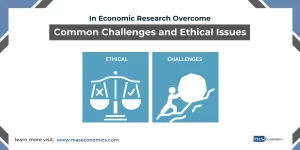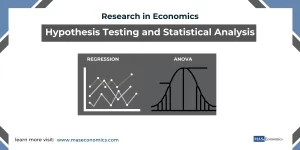A hypothesis is a testable statement that predicts a relationship between two or more variables. In economics, hypotheses play a critical role in guiding research by providing a framework for testing economic theories and exploring causal relationships. Whether you’re studying the effects of inflation on unemployment or the impact of interest rates on investment, hypotheses give structure to the research process by offering clear, testable propositions.
Hypotheses serve as the foundation for much of the quantitative and empirical research conducted in economics. By formulating hypotheses, economists can focus their studies on specific relationships, collect relevant data, and apply statistical methods to test their assumptions. This article explores the role of hypotheses in economics, explains the difference between null and alternative hypotheses, and offers practical examples of how hypotheses are tested in economic research.
The Role of Hypotheses in Economic Research
In economic research, hypotheses help transform theoretical ideas into testable statements that can be evaluated using real-world data. They provide direction to a study by identifying the specific relationships that researchers aim to investigate. Hypotheses are formulated based on existing economic theories, models, or observations, and their testing allows economists to conclude the validity of these theories.
Without hypotheses, economic research would lack focus and direction, making it difficult to test theories systematically or make informed predictions. Formulating a hypothesis ensures that the research process is logical and organized, moving from broad economic questions to specific, testable predictions.
For instance, consider an economist interested in understanding the relationship between inflation and unemployment. Drawing from economic theory, the economist might hypothesize that “an increase in inflation will lead to a decrease in unemployment in the short run.” This hypothesis, based on the Phillips Curve, provides a clear prediction that can be tested using statistical methods and real-world data.
Types of Hypotheses in Economics
Hypotheses in economics typically come in two forms: null hypotheses and alternative hypotheses. Understanding the difference between these two types is essential for proper hypothesis testing.
Null Hypothesis (H₀)
The null hypothesis is a statement that suggests no effect or no relationship between the variables being studied. In other words, it represents the default assumption that any observed differences or relationships are due to chance or random variation. The null hypothesis is often phrased as “there is no significant relationship between [independent variable] and [dependent variable].”
Example: Null Hypothesis in Inflation and Unemployment Study
In the context of studying inflation and unemployment, the null hypothesis might be:
H₀: There is no relationship between inflation and unemployment.
This hypothesis assumes that any observed changes in unemployment are not systematically related to changes in inflation.
Alternative Hypothesis (H₁)
The alternative hypothesis contradicts the null hypothesis. It is a statement that suggests there is a relationship or effect between the variables being studied. The alternative hypothesis is what the researcher aims to prove, and it typically aligns with the research question or theory being tested.
Example: Alternative Hypothesis in Inflation and Unemployment Study
Continuing with the inflation-unemployment example, the alternative hypothesis might be:
H₁: An increase in inflation leads to a decrease in unemployment.
This hypothesis reflects the economist’s belief, based on the Phillips Curve, that inflation and unemployment are inversely related in the short run.
The goal of hypothesis testing in economics is to determine whether the null hypothesis can be rejected in favor of the alternative hypothesis, based on the data collected.
Hypothesis Testing in Economics
Testing hypotheses in economics involves collecting data, applying statistical techniques, and determining whether the observed results support the null or alternative hypothesis. The process typically involves several key steps:
Formulate the Hypotheses
The first step is to clearly define both the null and alternative hypotheses. This provides a structured basis for the research and ensures that the study is focused on answering a specific question.
Collect Relevant Data
Once the hypotheses are formulated, the next step is to gather the data needed to test the hypotheses. In economics, this data often comes from sources such as government reports, financial markets, or surveys. For example, to test the relationship between inflation and unemployment, the researcher would need data on inflation rates and unemployment figures over a certain period.
Apply Statistical Tests
After collecting the data, the researcher applies statistical tests to determine whether the data provides enough evidence to reject the null hypothesis. Common statistical techniques used in hypothesis testing in economics include t-tests, chi-squared tests, and regression analysis. The choice of test depends on the nature of the variables being studied and the type of data available.
Evaluate the Results
Once the statistical tests are applied, the results are evaluated to determine whether the null hypothesis can be rejected. This typically involves calculating a p-value, which indicates the probability that the observed data would occur if the null hypothesis were true. If the p-value is below a certain threshold (commonly 0.05), the null hypothesis is rejected in favor of the alternative hypothesis.
Draw Conclusions
Based on the statistical analysis, the researcher draws conclusions about the relationship between the variables. If the null hypothesis is rejected, the researcher concludes that there is evidence supporting the alternative hypothesis. If the null hypothesis cannot be rejected, the researcher concludes that there is no significant relationship between the variables.
Practical Example: Predicting Relationships Between Inflation and Unemployment
To illustrate the process of formulating and testing hypotheses in economics, let’s return to the example of inflation and unemployment. An economist wants to test whether inflation affects unemployment, drawing on the Phillips Curve theory. The steps might look like this:
Formulate the Hypotheses
- Null Hypothesis (H₀): There is no relationship between inflation and unemployment.
- Alternative Hypothesis (H₁): An increase in inflation leads to a decrease in unemployment.
Collect Relevant Data
The economist gathers historical data on inflation rates and unemployment levels from government reports or international economic databases.
Apply Statistical Tests
The economist uses regression analysis to test the relationship between inflation (independent variable) and unemployment (dependent variable). This analysis helps determine whether inflation has a statistically significant impact on unemployment.
Evaluate the Results
After running the regression, the economist finds that the p-value for the relationship between inflation and unemployment is 0.03, which is below the threshold of 0.05. This means the null hypothesis can be rejected.
Draw Conclusions
The economist concludes that there is sufficient evidence to support the alternative hypothesis: higher inflation is associated with lower unemployment in the short run. This finding aligns with the Phillips Curve theory and has important implications for monetary policy.
Why Hypotheses Matter in Economics
Hypotheses are essential in economics because they provide a structured way to test theories and predict economic behavior. Without hypotheses, research would lack direction, making it difficult to draw meaningful conclusions from data. Additionally, hypotheses help economists distinguish between random variation and actual causal relationships, improving the accuracy of their models and predictions.
Well-formulated hypotheses also allow economists to test the validity of existing theories and propose new ones. For example, the Phillips Curve hypothesis, which suggests an inverse relationship between inflation and unemployment, has been tested and refined through decades of empirical research, leading to a deeper understanding of macroeconomic policy.
Conclusion
Hypotheses in economics are a critical part of the research process, providing a clear and testable framework for exploring relationships between variables. By understanding the difference between null and alternative hypotheses and applying proper statistical methods to test them, economists can draw meaningful conclusions about how different factors interact in the economy.
Whether studying inflation, unemployment, consumer behavior, or financial markets, mastering the art of hypothesis formulation is key to producing reliable and insightful economic research. As we continue through this series, we will explore other important aspects of economic research, including data collection methods and statistical analysis techniques.
FAQs:
What is a hypothesis in economics?
A hypothesis in economics is a testable statement that predicts a relationship between two or more variables. It helps guide research by providing a clear, structured framework to test economic theories and explore cause-and-effect relationships.
Why are hypotheses important in economic research?
Hypotheses are important because they give focus and direction to economic research. They transform theoretical ideas into testable statements, enabling economists to collect data, apply statistical methods, and evaluate economic theories systematically.
What is the difference between a null hypothesis and an alternative hypothesis?
The null hypothesis (H₀) suggests that there is no effect or no relationship between the variables being studied. The alternative hypothesis (H₁), on the other hand, proposes that there is a relationship or effect, and it is what the researcher aims to prove.
What is an example of a null hypothesis in economics?
An example of a null hypothesis in economics is: “There is no relationship between inflation and unemployment.” This assumes that any observed changes in unemployment are not related to inflation.
What is an example of an alternative hypothesis in economics?
An example of an alternative hypothesis in economics is: “An increase in inflation leads to a decrease in unemployment.” This hypothesis is based on the Phillips Curve theory, suggesting that inflation and unemployment are inversely related in the short run.
How do economists test hypotheses?
Economists test hypotheses by collecting data, applying statistical techniques, and evaluating the results. Common statistical methods include regression analysis, t-tests, and chi-squared tests, which help determine whether the data supports the null or alternative hypothesis.
What is a p-value in hypothesis testing?
A p-value is a statistical measure that indicates the probability of observing the data if the null hypothesis is true. If the p-value is below a certain threshold (commonly 0.05), the null hypothesis is rejected, indicating that there is evidence supporting the alternative hypothesis.
How does hypothesis testing contribute to economic research?
Hypothesis testing allows economists to validate or refute economic theories based on real-world data. It helps distinguish between random variation and actual causal relationships, improving the accuracy and reliability of economic models and predictions.
Can you provide an example of hypothesis testing in economics?
For example, an economist might test the hypothesis that “inflation leads to lower unemployment.” They would collect historical data on inflation and unemployment, use regression analysis to test the relationship and evaluate whether the results support or reject the hypothesis.
What role do hypotheses play in economic theory?
Hypotheses are crucial in testing and refining economic theories. By formulating hypotheses based on existing theories and testing them with data, economists can validate, adjust, or propose new theories, contributing to a deeper understanding of economic phenomena.
Thanks for reading! Share this with friends and spread the knowledge if you found it helpful.
Happy learning with MASEconomics




